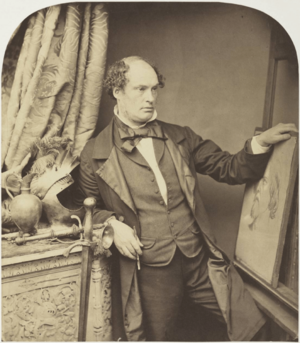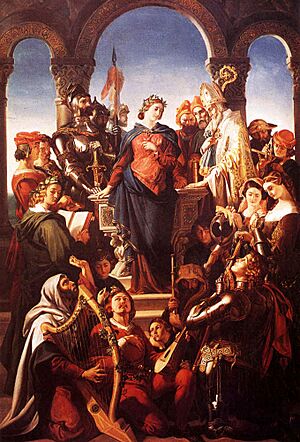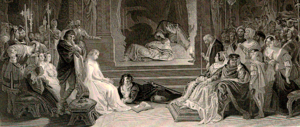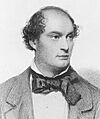Daniel Maclise facts for kids
Quick facts for kids
Daniel Maclise
|
|
|---|---|

Daniel Maclise photographed by William Lake Price
|
|
| Born | 25 January 1806 Cork, Ireland
|
| Died | 25 April 1870 (aged 64) Chelsea, England
|
| Nationality | Irish |
| Known for | History painting; Portrait painting |
Daniel Maclise (born January 25, 1806 – died April 25, 1870) was a famous Irish artist. He painted historical scenes, portraits, and illustrated books. Daniel Maclise spent most of his life working in London, England.
Contents
Early Life of a Talented Artist
Daniel Maclise was born in Cork, Ireland. His father was a shoemaker. Daniel didn't have a fancy education. But he loved to read and wanted to be an artist.
In 1820, his father got him a job at a bank. Daniel worked there for two years. Then he left to study art at the Cork School of Art.
A special moment happened in 1825. The famous writer Sir Walter Scott was visiting Ireland. Young Maclise saw him in a bookshop. He quickly drew a secret sketch of Scott. This sketch was later printed and became very popular. It led to many requests for Daniel to draw portraits using pencil.
Many important people saw Daniel's great talent. They wanted to help him study art in London. But Daniel refused their money. He saved up his own money instead. He arrived in London on July 18, 1827. There, he drew a sketch of the actor Charles John Kean. This sketch was also printed and earned him a lot of money. In 1828, he joined the Royal Academy schools. He won the top awards there.
Daniel Maclise's Career
Daniel Maclise first showed his art at the Royal Academy in 1829. Over time, he started focusing more on paintings about history and stories. He also painted portraits of friends. These included writer Charles Dickens and Lord Campbell.
In 1833, he showed two paintings that made him even more famous. By 1835, his paintings Chivalric Vow of the Ladies and Peacock helped him become an associate of the Royal Academy. He became a full member in 1840. In the following years, he painted many pictures. Their subjects came from history, old stories, and plays by Shakespeare.
Illustrations and Famous Portraits
Maclise also drew pictures for several of Dickens's Christmas books. Between 1830 and 1836, he drew a special series of portraits. These were for Fraser's Magazine. He used the pen name Alfred Croquis. These drawings showed famous people of the time. They were like quick sketches, sometimes a bit like cartoons. Later, they were published as the Maclise Portrait Gallery.
Painting for the Houses of Parliament
When the Houses of Parliament were being rebuilt, Maclise got a big job. In 1846, he was asked to paint large pictures on the walls of the House of Lords. These paintings showed ideas like Justice and Chivalry.
In 1858, Maclise started one of his two most important works. This was The Meeting of Wellington and Blücher after the Battle of Waterloo. It was painted on the walls of Westminster Palace. He first tried to paint it using a method called fresco. This is painting on wet plaster. But it was too difficult. Daniel wanted to quit. However, Prince Albert encouraged him. So, he learned a new way of painting called water-glass painting. He used this method for the Wellington painting. He also used it for its partner painting, The Death of Nelson. He finished the Nelson painting in 1864.
Other Important Works
Maclise's huge painting The Marriage of Strongbow and Aoife (1854) is in the National Gallery of Ireland in Dublin. It shows a marriage between a Norman conqueror and an Irish princess. There is also a wall painting by Maclise at the Halifax Town Hall.
Working on these big historical paintings was very hard. It affected Daniel's health. He started to avoid friends and lost his cheerful mood. In 1865, he was offered the chance to be the president of the Royal Academy. But he turned it down. He passed away from a serious lung illness on April 25, 1870. He died at his home in Chelsea.
His paintings are known for being very smart and imaginative. Some critics felt his colours were a bit dull. They also thought his figures sometimes looked a bit too dramatic. But his most famous works are the two large paintings in Westminster.
Exhibitions After His Death
National Portrait Gallery, 1972
In 1972, Daniel Maclise's portraits were shown. This was at an exhibition in the National Portrait Gallery.
Crawford Art Gallery, 2008
The Crawford Art Gallery in Cork, Ireland, held a big show of his art. It was called Daniel Maclise: Romancing the Past. It ran from October 28, 2008, to February 14, 2009.
Royal Academy, 2015
A first sketch for The Meeting of Wellington and Blücher was shown. It was at the Royal Academy of Arts. This was from September 2, 2015, to January 3, 2016. It marked 200 years since the Battle of Waterloo. Before that, it was shown at the Royal Armouries in Leeds.
Images for kids





